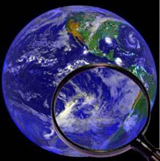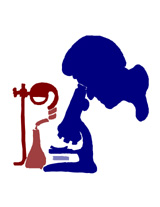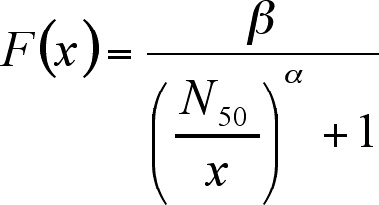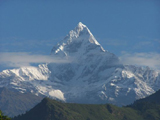Science
Beyond paradigms — IV
Editor’s note
The modern approach to knowledge is based on reason. Sri Aurobindo has explained that the future approach to knowledge will be based on a developed and structured intuitive foundation which will automatically do the work that reason now accomplishes and, at the same time, will discern supra-rational seed-ideas, placing them in the correct context, making way for the Truth to manifest without the hindrances we face today.
Science is a path that mankind has taken in its search for Reality, Truth, Power, Mastery and Conquest of nature. Spirituality too is a path that leads towards the same goals. However the two paths move in different directions, even though ultimately they move towards the same goal.
Material science
It begins its probe by examining the world outside, — the world of material objects and physical phenomena. It uses the only instruments available to the scientist, — the senses embedded in matter and the rational, analytical, mathematical mind which cuts reality into bits and pieces and then tries to build up the whole. Having probed matter, it graduates into the world of living forms and then from there takes a further giant step into the inner subjective world of man, — the world of thoughts and feelings, hopes and aspirations, dreams and fantasies.
But its explorations cannot stop there. By its inherent nature and impulsion, it must leap further and try to touch and test the flaming heart of the spiritual consciousness. Indeed like every major breakthrough in any field, it is essentially, a leap of faith. Impelled by a secret śraddhā, an instinct with a secret intuition that there is a truth to find — deeper and deeper layers of Reality, unifying principles that govern the laws of nature — it moves along its path one step at a time, groping blindly through the walls of material form.
There are however three cardinal errors that material science makes in its search: three errors of assumption:
First, it assumes that Reality is a single-layered sheet of material substance spread out in time and space.
Second, it assumes that the natural instruments given to us — the senses and the analytical mind — can at best be augmented in capacity but not changed in quality.
Third, it assumes that there is only one method of knowledge and that is the rational and analytical way.
The irony is that life and psychological sciences see these assumptions being contradicted all the time and yet, hypnotised by the ‘success’ of the physicist’s method and dealing with matter, these later sciences follow in their older sibling’s footsteps, blindly adoring it despite all its stumblings and fumblings. For, unlike the field of matter, the life sciences and mind sciences move in a field that is at once far more flexible and subtle. The laws in these fields are less rigid, their boundaries less marked. Living systems are in a constant dynamic interchange with their environment. They are far more porous and liable to change and adapt at any given moment. The stability in living systems is more a matter of habitual repetition than any fixed law or rigid rule of nature. So to study them as one would study a physical object or to apply mathematical models to fix their limits is not the best way to understand them. The only way we can fruitfully study living systems is by observing how they respond to challenges: how they adapt to crisis and the cry for rapid change. With human beings we need to go a few steps further. For we can adapt and change not only in response to external environmental forces but also to internal conflicts, inner needs, inner psychological forces and subjective conditions. Besides, becoming aware of a vast subjective existence within, a human being has far more and complex inner needs than say, an animal or a plant. He has to adapt, adjust and evolve not only in relation to the external but also with regard to his internal world. But our natural instruments have evolved in relation to the outer world or, at best, to register simple internal uses such as that of hunger and thirst. Though we use the word ‘instinct’, instinct is not really something blind. It is simply another kind of knowledge ‘sensed’ through other kinds of instruments.
When we study a human being through the ‘objective’ analytical method and apply to man the logic of the machine or even the animal, then we miss out on something crucial and even fundamental, — the subjective side of human existence. We gain external knowledge but become oblivious to internal riches. We augment our physical senses through the telescope and microscope and study physical objects better, but lose out on a wealth of inner phenomena. Even when our inner senses, through which we register the impacts of internal states, begin to dwindle we lose our inner richness,— richness of thoughts, richness of feelings, richness of imagination, richness of inner experiences. An extreme result of this excessive stress on a purely mechanical model of humanity is a dehumanisation or a robotisation of life and man. The consequences are obvious and have naturally led to alarm among those who are inwardly conscious of the detrimental effects that scientific materialism has had and continues to have: a mechanical order, fixed upon hinges of sense-evidence and governed by the reason with analysis as its tool, replacing the natural evolutionary professions. Jobs, relationships, success, everything is decided, based on external, objectively observable and measurable indications rather than a natural intuition about life, what the Indian thought poignantly termed svadharma and svabhāva. Man is then a machine among other machines, his life a mathematical formula, his thoughts and feelings a chemical reaction, his soul and spiritual ecstasy and peace simply a glandular secretion. The result is there for all to see.
Spiritual sciences
These have taken another approach. They start by probing the internal subjective world of man. But unlike ‘modern mainstream psychology’, which is a dumb and blind follower of the material sciences, it has evolved its own methodology and criteria suited to the field of its study. The method it pursues is first and foremost to augment the internal senses through which we register internal events. Thus, the awareness to ‘know’ and ‘see’ what we think is augmented by paying attention to our thoughts; the awareness of feeling is increased by becoming conscious of fleeting feelings, subtle emotions that ordinarily escape our attention. The awareness of our will is increased by sincerely observing the various motives that give us the covers that we use to hide or justify our real intent. This is done generally through sincere self-reflection and self-observation. This increases the range of awareness in the field of thought, feeling and will, thereby making conscious in us what is still unconscious. This helps in many ways. For example, we keep on blaming others for whatever happens in our lives. By constantly complaining about people and things outside us, we begin to lose our autonomy and unwittingly become dependent, if not a slave to all that is outside us and beyond our control. When we look inside carefully, we will observe what is within us ‘attracts’ whatever happens to us. This gives an autonomy and control; it opens the road to freedom and mastery. It helps in the growth of sincerity and humility since we see that, whatever we despise or hate in another, is present in some form or other within us. But since in our emotional and thought-fields we are not bound by the body alone, we begin to become aware of the energy in the thought-fields and emotional-fields of others, even of their hidden motives. Finally, we see the play of these energy-fields and observe how one person’s energy-field not only extends into those around him or to those he is attached to even if afar, but also how each of these fields influences another, even passes on to others much as the seed of man passing into a woman gives birth to an offspring, embodying their (the parent’s) difficulties and possibilities in a unique way. This seeding of thoughts and feelings and will into others is termed as a mental and vital interchange through which we unwittingly pick up and pass on the ‘good’ and ‘ugly’ side of each other.
Self-awareness makes us conscious of the whole gamut of events and processes happening in our inner psychological field. Scientific instruments tuned to pick up purely material phenomena cannot record or measure these things.
At the next level, we discover that depending upon our faith and will — the two important powers of the inner life — we can shift and move our thoughts and feelings upwards or downwards. The more concentrated we are in our will, the more complete is our faith, the greater the power of the shift. An upward shift makes us conscious of higher modes of thoughts, subtler feelings, a greater power of will. The energies of these higher fields are subtle, clean, harmonious, full of peace and joy and thereby also more powerful in a way. By opening ourselves to these higher domains, we create within and around us conditions of peace and harmony, joy and health, an ease and natural mastery over events and circumstances that surround our life. On the other hand, when we gravitate down, we experience in our subjective being a state of dullness and obscurity, restlessness and excitement, depression and despair, confusion and chaos. The same begins to reflect in our surroundings and our life becomes a bundle of confusion, a chaos of conflicting energies. But we also discover that the higher and lower are interconnected, the latter is a shadow of the former. Thus, each time we can work upon and cut through a layer of obscurity and darkness within us by bringing there some light, some peace, some consciousness, it becomes that much easier for us to climb higher and fly into vaster domains of thoughts and feelings and will. Equally, the higher our flight, the greater our capacity to work upon even more obstinate layers of resistances and dissolve even denser shadows within us.
Finally, following this trail, swimming through seas of luminous thought, the spiritual and yogic science takes its own leap of faith. Tracing the upward path it seeks to find the source, the origin of all thoughts and ideas, of all feelings, of all will. It discovers that thought is merely a vehicle to convey an ‘Idea’ that is at the root of creation. The idea itself is only a phalanx of ‘Knowledge’ that extends itself through the Idea-force into all things. Knowledge itself is found to be a state of utter identity and oneness with all things. To put it mystically, it is to discover our identity with the ‘one’ that has become the ‘many’. So to dwell in the sense of the ‘many’ and be completely oblivious of the ‘One’ is regarded as ignorance. So to discover the one Reality and through that our essential identity with all things is considered a state of knowledge. Naturally, this state of knowledge is as far removed from our so-called acquired information and analytical-rational, philosophical scientific knowledge as our ‘artificial’ lights are from the sun, even though both seem to serve ‘apparently’ a similar purpose.
True knowledge of the one Reality, like all knowledge that goes to the root of things, empowers us to change internal and external appearances.
LoveSo too, following the upward trail of feelings, refining, purifying and subtilising them, one discovers that all feeling states can be resolved into love. When we trace it further up, we find that love ascends from a state of sorrow and suffering to a state of beatitude. This beatitude is a self-existent condition, independent of anything external. It holds all existence in its vastness as a mother holds her baby in the womb and nourishes it. Going further, one discovers that love is the flower and beatitude the fruit that blooms on the tree of bliss. Bliss is the sap that runs in all things as the sustaining energy. Bliss harmonises and heals everything.
Finally, when we take the trail of will and impulsion that moves all things, we see that it ascends tier by tier from a state of mechanical force driving all Nature’s processes. This mechanical force changes into instinct and then conscious intent. Ascending further, it becomes an intuition that moves and arranges all things according to a certain law of harmony and order. Still further, it becomes the power of truth that acts as a secret compulsion in all creation. At the highest summits, we can become aware of a supreme Consciousness-Force that is at once omnipotent, omniscient and omnipresent.
A last great leap and the explorers of the inner worlds touched the one Triune Reality in which the one Existence, Consciousness and Bliss fuse and become one. Drawing into that unique, marvellous fount and origin, the Being of Saccidaananda, they plunged deep, forgetting earth, forgetting the mundane, forgetting the material universe and all else that it contains. Again a great dichotomy was the result, — a rich inner life but an outer impoverishment.
Both these paths have arrived at their own unique experience in the understanding of truth.
The two must meet. The bridge must be found that connects the two extremes, the link between heaven and earth, the mediating stair between the earth and the Beyond…
Dr. Alok Pandey is a doctor practising at the Sri Aurobindo Ashram.
Share with us (Comments, contributions, opinions)
When reproducing this feature, please credit NAMAH, and give the byline. Please send us cuttings.


 Analytical method
Analytical method
 Life?
Life?
 Seed of man
Seed of man

 Highest summits
Highest summits